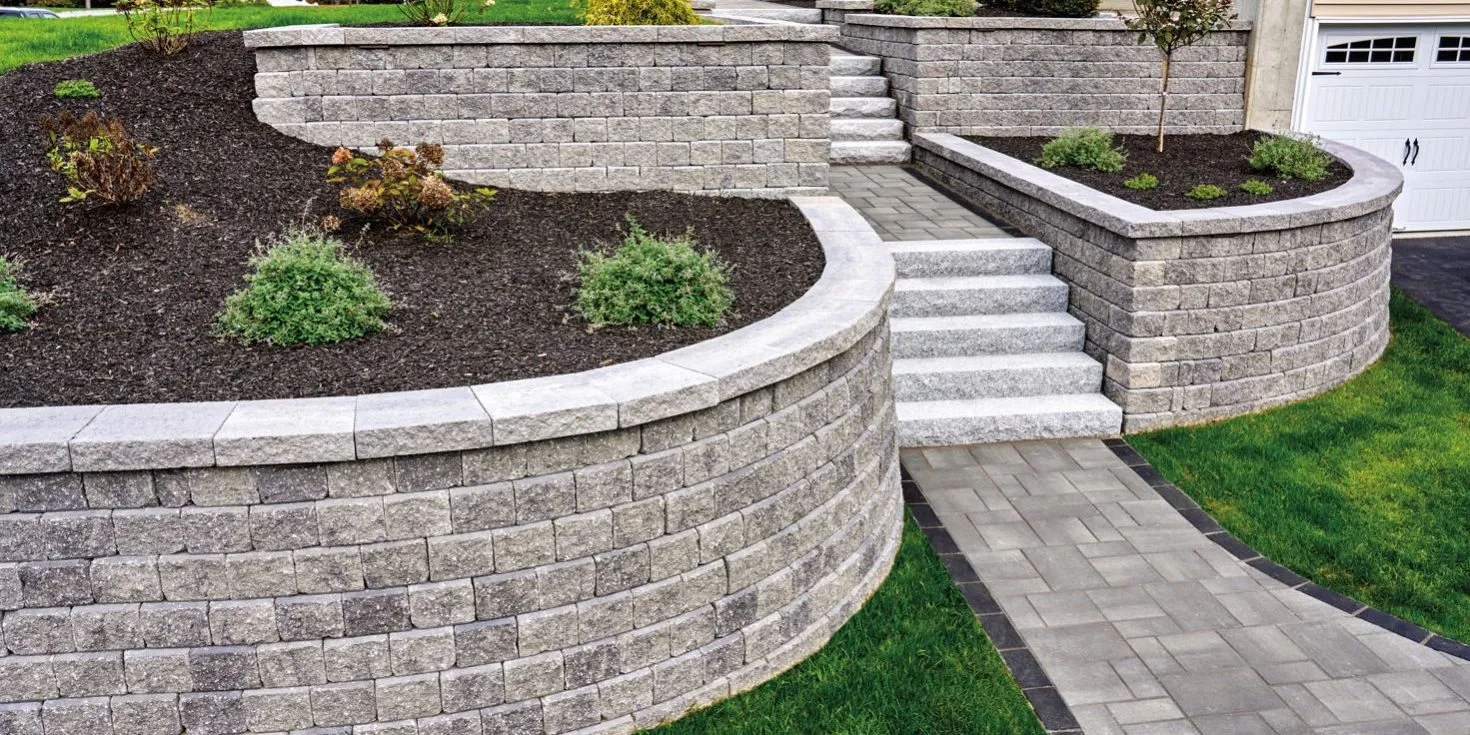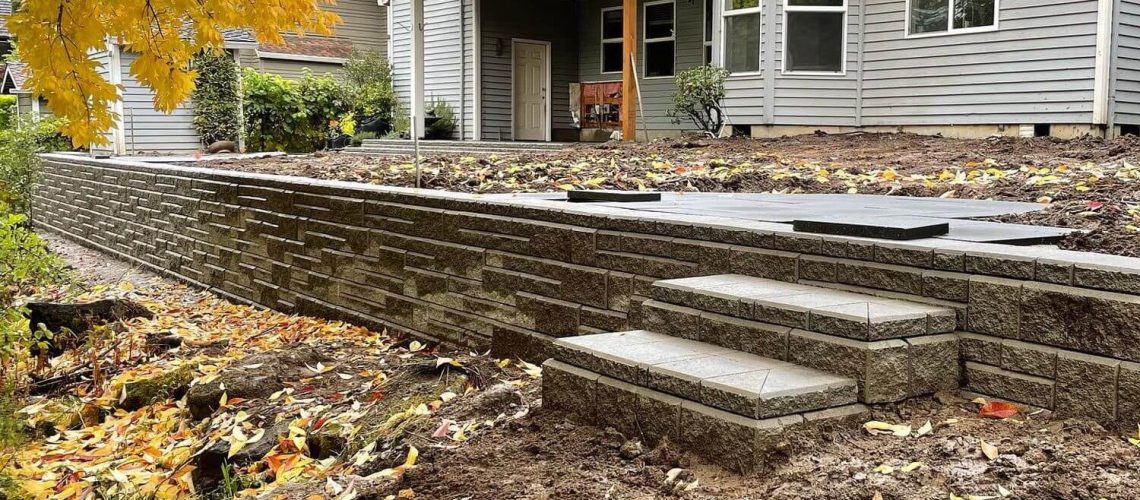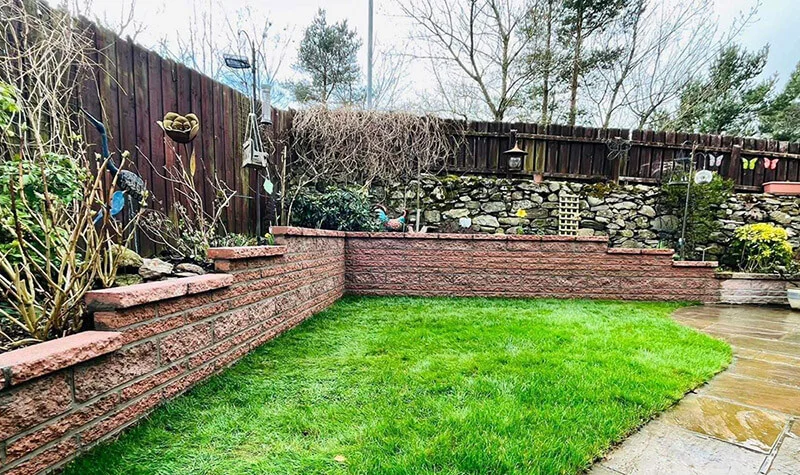
Retaining walls are more than just garden features — they’re structural systems that hold back soil, prevent erosion, and shape multi-level outdoor spaces. In this post, we take you behind the scenes at Plex to show how our team designs and builds retaining walls that stand strong through Worcestershire’s changing seasons. Learn what materials, drainage systems, and engineering techniques ensure every wall looks beautiful and lasts for decades.
See how we can help you!
Many garden retaining walls eventually crack, bow, or collapse. The reason is almost always the same: poor drainage or insufficient foundations. In clay-heavy Worcestershire soils, water retention behind walls creates hydrostatic pressure — a silent force that can push over even the strongest-looking wall.
At Plex, our process starts with a ground assessment and engineering design that accounts for soil type, slope angle, and water movement. By understanding how the land behaves through wet and dry seasons, we ensure each wall has the correct footing, reinforcement, and drainage to perform year after year.
Before a single block is laid, our team conducts a detailed survey. We look at slope gradients, existing drainage paths, and the type of soil on site. Clay soils in Worcester and Droitwich, for example, expand when wet and contract when dry — putting stress on any unsupported structure.
Our engineers calculate the retained height and expected soil pressure. This determines not only the size and thickness of the wall but also the type of footing, material, and reinforcement required. For tall or load-bearing walls, we use BS EN 1997 (Eurocode 7) soil stability standards to ensure full compliance.
Every retaining wall is only as strong as its foundation. We excavate down to a firm subsoil layer, removing all loose or organic matter. Depending on wall height and soil conditions, the footing depth usually ranges from 150mm for small garden terraces to 600mm or more for structural walls.
We then install a compacted MOT Type 1 base layer, followed by steel-reinforced concrete footings. These distribute the wall’s weight evenly and prevent settlement over time. The key here is achieving a perfectly level and stable base — the smallest unevenness can lead to long-term leaning or cracking.
Without proper drainage, even a perfectly built wall will eventually fail. As rainwater seeps into the ground, it collects behind the wall, creating hydrostatic pressure that pushes outward.
To prevent this, we install perforated land drains (often 100mm pipes) at the wall base, covered in clean stone and geotextile fabric. This allows water to escape freely. We also backfill with free-draining aggregate rather than compacted soil, further reducing pressure.
In areas like Malvern or Pershore, where rainfall can be intense, we sometimes include weep holes through the wall to provide additional water relief.
Depending on the site and design, we use one of several proven retaining wall systems:
Each wall type requires precise alignment and backfilling at every stage. For reinforced concrete or block systems, we install steel rebar grids and concrete pours in layers, allowing controlled curing and maximum tensile strength.
Once the wall structure is complete, we carefully backfill the area behind it. This isn’t just dumping soil back in — each layer is compacted in stages to prevent settling and to maintain stability. We typically use angular stone or clean gravel closest to the wall for drainage, transitioning to compacted subsoil further back.
Poor backfilling is one of the most common causes of retaining wall failure, so this step is given as much attention as the wall itself.
After the structure is complete, our team integrates the retaining wall into the overall garden design. This might include paved terraces, steps, or planters built into the wall for seamless visual flow.
In formal gardens across Worcester or Bromsgrove, rendered finishes or natural sandstone cladding create a contemporary look, while rural settings often suit Cotswold stone or timber sleepers for a more natural aesthetic.
We also install topsoil, planting schemes, and lawn edging to ensure the wall blends naturally into the surrounding landscape.

A neglected garden reimagined into a stunning rustic retreat, featuring reclaimed brickwork, a charming patio, and vibrant planting—blending timeless character with thoughtful design.

A complete garden overhaul in Cheltenham, transforming an overgrown, rat-infested space into a sleek, low-maintenance outdoor oasis with porcelain paving, integrated lighting, and a rat-proof brick wall.
Worcestershire’s ground conditions can vary dramatically — heavy clay in the Vale of Evesham, sandy loam in parts of Redditch, and rocky subsoils near the Malvern Hills.
Understanding how each soil type affects drainage and stability allows Plex to adapt our designs accordingly. For example, clay soils require deeper footings and enhanced drainage layers, while sandy soils demand compaction and moisture retention strategies.
This local expertise ensures our retaining walls remain upright and effective no matter the terrain or weather.
All retaining walls built by Plex follow British Standard BS 8002 for earth-retaining structures. From excavation safety to material testing, our projects are carried out with engineering precision and structural integrity at their core.
According to the Institution of Structural Engineers, over 80% of retaining wall failures in the UK are linked to poor design or drainage — both issues we eliminate through detailed planning and execution.
1. Foundations determine everything.
A retaining wall’s strength starts underground — deep, level concrete footings prevent shifting or collapse.
2. Drainage is non-negotiable.
Hydrostatic pressure is the leading cause of failure. Weep holes, land drains, and free-draining aggregate stop water buildup.
3. Material choice affects durability.
Concrete, stone, and sleeper systems each perform differently depending on site conditions and desired aesthetics.
4. Soil type must guide design.
Clay, loam, and sandy soils each expand, contract, or drain differently — expert local knowledge prevents structural stress.
5. Professional engineering ensures safety.
Following BS 8002 standards guarantees stability, compliance, and peace of mind for years to come.

.webp)
.webp)
.webp)
.webp)
.webp)
.webp)
.webp)
.webp)
Not all retaining walls are built the same — and how they perform over time depends heavily on materials and method.
Concrete block retaining walls are the strongest, ideal for heavy loads or multi-tiered gardens. When reinforced with rebar and concrete-filled cores, they can easily withstand the pressures of high embankments or vehicle loads.
Gabion retaining walls provide natural flexibility and self-draining performance. Their stone-filled cages move slightly with the ground, preventing cracks — making them popular in Worcestershire’s wetter, rural areas.
Timber sleeper walls offer a softer, more natural appearance but typically last 10–20 years depending on treatment and installation. They’re excellent for raised beds or decorative terraces where full structural load-bearing isn’t required.
Natural stone walls, when properly built with modern drainage, combine aesthetics and durability. Many still stand strong after 50 years or more — but only when laid with solid footings and back drainage.
The secret isn’t the material itself — it’s the method behind it. At Plex, every retaining wall is engineered for its environment, ensuring it complements the landscape while remaining structurally sound.

A retaining wall may seem simple from the outside, but beneath its surface lies complex engineering and craftsmanship. From precise excavation to controlled drainage and reinforcement, every stage is critical to its strength and appearance. At Plex, we believe great landscaping starts with structure — and our retaining walls are built to perform, not just to please the eye. Whether supporting garden terraces in Worcester or creating elegant split-level landscapes in Evesham, our approach ensures your walls remain stable, attractive, and enduring for years to come.

Retaining walls are more than just garden features — they’re structural systems that hold back soil, prevent erosion, and shape multi-level outdoor spaces. In this post, we take you behind the scenes at Plex to show how our team designs and builds retaining walls that stand strong through Worcestershire’s changing seasons. Learn what materials, drainage systems, and engineering techniques ensure every wall looks beautiful and lasts for decades.

Concrete bases form the foundation of countless garden and landscaping projects — from sheds and summerhouses to patios and extensions. In this post, we take you behind the scenes at Plex to show how our teams prepare, pour, and finish professional concrete bases across Worcestershire. You’ll learn what really goes into the groundwork, why precision is essential, and how a well-built base ensures long-term stability for any outdoor structure.
.webp)
Ever wondered what really goes into preparing a professional patio or garden path? In this post, we take you behind the scenes at Plex to show the full process — from excavation to sub-base compaction — that ensures every surface stays level, strong, and long-lasting. Learn the science, precision, and materials that make the difference between a short-lived patio and one that lasts decades.